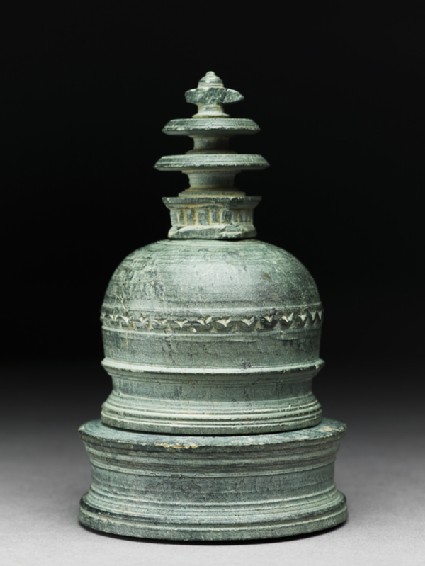Browse: 10610 objects
- Reference URL
Actions
Reliquary in the form of a stupa
-
Details
- Associated place
- Date
- 1st century AD (AD 1 - 100)
- Material and technique
- grey schist
- Dimensions
-
11.8 cm (height)
6.8 cm (diameter)
- Material index
- Technique index
- Object type index
- No. of items
- 10
- Credit line
- Purchased with the assistance of the Friends of the Ashmolean Museum, 1978.
- Accession no.
- EA1978.127
-
Further reading
Harle, J. C., and Andrew Topsfield, Indian Art in the Ashmolean Museum (Oxford: Ashmolean Museum, 1987), no. 19 on p. 16, pp. 9, 14, 38, & 56, illus. p. 16
Cambridge: Fitzwilliam Museum, 6 October-13 December 1992, The Crossroads of Asia: Transformation in Image and Symbol in the Art of Ancient Afghanistan and Pakistan, Elizabeth Errington, Joe Cribb, and Maggie Claringbull, eds, 90 (Cambridge: Ancient India and Iran Trust, 1992), No.174
Vienna: Kunsthistorisches Museum, 2 April-16 July 1995, Buddha in Indien: Die frühindische Skulptur von König Asoka bis zur Guptazeit, Deborah E. Klimburg-Salter, ed. (Vienna: Kunsthistorisches Museum and Milan: Skira, 1995), no. 125 on p. 155, illus. p. 155 fig. 125
Branfoot, Crispin, ‘Pilgrimage in South Asia: Crossing Boundaries of Space and Faith’, Ruth Barnes and Crispin Branfoot, eds, Pilgrimage: The Sacred Journey (Oxford: Ashmolean Museum, 2006), p. 56, illus. p. 57 fig. 51
Oxford: Ashmolean Museum, 2006, Pilgrimage: The Sacred Journey, Ruth Barnes and Crispin Branfoot, eds. (Oxford: Ashmolean Museum, 2006), p. 56, illus. p. 57 fig. 51
Location
Objects are sometimes moved to a different location. Our object location data is usually updated on a monthly basis. Contact the Jameel Study Centre if you are planning to visit the museum to see a particular object on display, or would like to arrange an appointment to see an object in our reserve collections.
Galleries
Publications online
-

Indian Art in the Ashmolean Museum
This small reliquary in the form of a stūpa underlines the earliest role of the stūpa as the repository of mortuary remains, in other words the stūpa as a giant reliquary. An early text refers to stūpas being built over the widely distributed remains of the Buddha.
The stūpa is the monument par excellence of Buddhism and particularly the more primitive observance which flourishes to this day in Sri Lanka, Burma and Thailand. In the first two centuries ancient stūpas whose foundations go back to the first millennium B.C. and reaching a diameter of 295 ft. (90 m), still survive intact and are objects of great veneration.
The earliest stūpa to survive intact in approximately its original form is Stūpa II at Sañci, 2nd-1st century B.C. It has a low, less than hemispherical dome, surrounded, as an object of veneration, by a stone fence, one of the vedikās of which portions are illustrated in [EA1983.24 and EAX.391]. By the Kuṣāṇa period, the dome stands raised on a cylindrical element, as illustrated in the Museum’s little reliquary. Examples of such stūpas, illustrated on countless reliefs, actually survive in Afghanistan and Swat (northern Pakistan). The shape of the square harmikā (the little railed platform on top of the dome) exactly reproduces the shape of this feature in the rare cases where it has survived: the stylised pyramid of parasols, only three in this relatively early example, is well known from stone reliefs and terracotta sealings depicting stūpas.
The contents of the stūpa consisted of two little gold boxes and one silver one, now empty.
© 2013 University of Oxford - Ashmolean Museum














